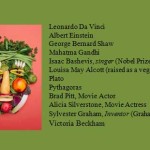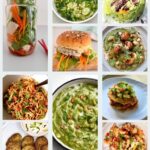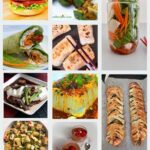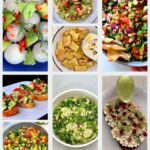Vegan diets should consist mainly of vegetables and whole grains. This may seem obvious, but it takes some effort to accept and put into practice, when you’re used to a meat-based diet. The tendency is to substitute soy protein for meat, and keep everything else the same, which isn’t a real nutritional gain, and in fact, often quickly leads to malnutrition. When you’re planning meals, think of vegetable, grain, and protein, in combination. Too much of everything isn’t a good thing, so don’t feel you have to eat all whole grains all the time. The following concepts kept in mind for any vegan meal plan will achieve healthy results.
Basic Nutritional Concepts
- All nutrients needed by the body are available through food.
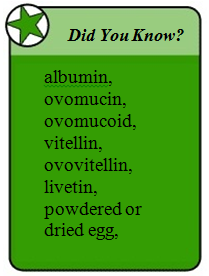
- Many kinds of food and food combinations can lead to a well-balanced diet.
- No food, by itself, has all the nutrients needed for full growth and health. Each nutrient has specific uses in the body.
- Most nutrients do their best work in the body when teamed with other nutrients.
- All persons need the same nutrients, but in varying amounts.
- The total nutrients needed by one’s body are influenced by age, sex, size, activity, and the state of health.
Guidelines for a Well-Balanced Vegan Nutrition
These AREN’T hard, fast rules, and are more like suggestions, based on the principle that food is to enjoy. If you follow these guidelines, even loosely, it will be a lot easier for you to have balanced and complete vegan nutrition.
1.Read the labels. Sad to say, both vegan fast food and processed food, even when labeled organic, aren’t much better than non-vegan. Processed food, including ‘natural food’ generally has the life processed right out of it, and is often full of preservatives, artificial coloring and flavoring, hydrogenated oil, GE ingredients, etc.
2.Who can be good all the time? It is but human to want to eat things that are bad for one’s health, once in a while. Deep fried potato scallops, chocolate, or ice cream (vegan of course!) is not considered staple diets. Whenever you feel the need to indulge, you have to discriminate and buy organic, or better yet, make your own.
3.Go for organic food as much as possible. They may cost more mainly due to the fact that farming for organic food is done on a much smaller scale and that farmers don’t receive agricultural subsidies, nevertheless, the superior taste and nutrition less the pesticides and herbicides, will be worth the extra cost.
4.Buy locally grown, fresh picked vegetables and fruit, as much as you can. Remember that vegetables and fruits lose nutrients as they lose freshness. The lesser the time you eat them after picking, the more taste and nutrients you will get.
5.Consciousness, love, and pleasure in the making. These give subtle qualities to food, which nourish just as much or more than the quantifiable nutrients.
6.Cook your own food, from scratch, whenever possible. It’s fresher and gives you comfort especially as you know what’s in it. You can make it just as you like and even cost you less.
7.Use leftovers with caution. For most of us, eating leftovers is a fact of life, if not a way of life. The idea is to use fresh ingredients, eat immediately, and try not to have leftovers. Not always possible, but something to keep in mind.
8.Be aware of nutrient robbers. Heavy uses of refined sugar, salt and flour, hydrogenated fat, carbonated beverages, food preservatives, tobacco, alcohol, and recreational drugs – causes malnutrition. What you put in your body should count, nutritionally.


